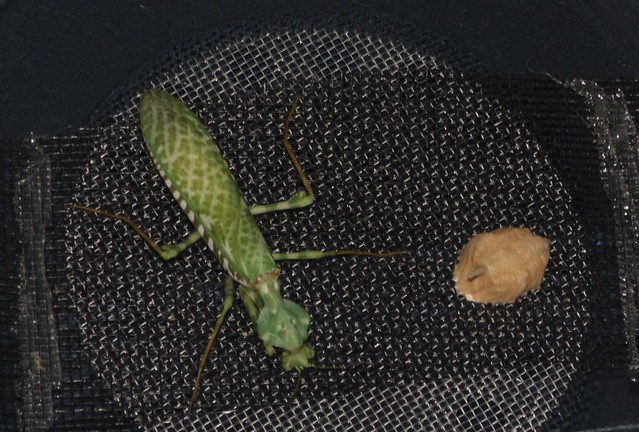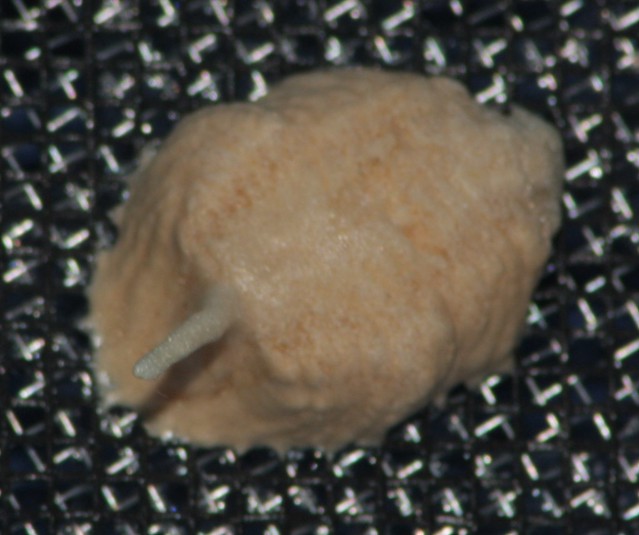If you could share that system with all of us I think that would be greatAlex, you may want to put some water droplets on your hand and see if she is thirsty. I never spray my adults, but if she didn't have food for a while, then she may be dehydrated.
I have a feeding system that works well when one is away for about 7 - 9 days. I can't remember if I emailed you the details...
You are using an out of date browser. It may not display this or other websites correctly.
You should upgrade or use an alternative browser.
You should upgrade or use an alternative browser.
Blepharopsis Consolidated
- Thread starter agent A
- Start date

Help Support Mantidforum:
This site may earn a commission from merchant affiliate
links, including eBay, Amazon, and others.
will doAlex, you may want to put some water droplets on your hand and see if she is thirsty. I never spray my adults, but if she didn't have food for a while, then she may be dehydrated.
I have a feeding system that works well when one is away for about 7 - 9 days. I can't remember if I emailed you the details...
my feeding system is simple
if gonna molt-2 fiies
if not gonna molt-whole handful of flies...
u never emailed me the details but please do
Glad he is pissing you off (and survived the blaze!), I trained him well.your male is a HUGE pain in the arse :lol:
i threw like 12 flies in his cage before vacay
guess wat
ALL gone and he is STILL skinny
other than that he is fine
lucky he didnt burn alive like my male and our females' sis in uknowwho's little blaze
and to the person who STARTED the fire, i am NOT still mad about it i come from an area where it is perfectly acceptable to continue talking or joking about some flaw or mistake someone made LONG after the issue was resolved so please dont get offended we here in my family still joke about when i accidentally pushed my sis down the basement stairs when i was like 5...
he survived the blaze cause he wasnt in itGlad he is pissing you off (and survived the blaze!), I trained him well.
the person who roasted the other pair was origionally supposed to get an ooth of them in trade for a limbata ooth
but i decided instead to send a pair, which he kept too close to a heat lamp and killed them, my unicorn female, and my creo female
BUT i gotta give him credit for getting both my californica to adult and keeping my lobata safe as they molted to L2...
oh yeah and TAMMY!!!
i love your idea of 80oz deli cups
BUT...
when they fall or something they come open too easily
i always drop my bleph cages and they open AND while i was away a windstorm knocked over an 80 ouncer with a lineola in it and she escaped
so if she survives and turns parthenogenic and overtakes CT u, me, and hibiscusmile will be in a heap of trouble :lol:
i love your idea of 80oz deli cups
BUT...
when they fall or something they come open too easily
i always drop my bleph cages and they open AND while i was away a windstorm knocked over an 80 ouncer with a lineola in it and she escaped
so if she survives and turns parthenogenic and overtakes CT u, me, and hibiscusmile will be in a heap of trouble :lol:
lineola? even for final molt?Mine do fine in 24oz cups. They don't seem to wander much.
i was in your area today but my mom wouldnt let me go say hi <_<
Last edited by a moderator:
It's helpful if you still have someone spray the appropriate mantises now and then.As for feeding mantises that eat bb flies, I buy bb larvae (aka "spikes" not pupae) a few weeks ahead of time and put them in the refrigerator. They usually take 7 - 9 days to eclose. So, about 8 days before I leave, I take the appropriate number of flies needed for each mantis and put them in a container on the counter to allow them to develop. Within a day or two they usually are in the pupae stage. I take out larvae every day for a week and end up with 7 containers full of pupae. Then the day before I leave, I drop the appropriate # pupae into each enclosure (e.g., my female b mendica each get 3 bb pupae each day. For a one week trip, they would have 21 pupae). In theory some bb flies should hatch every day. For extended trips that last 10 - 12 days, I take out extra larvae on the last day.If you could share that system with all of us I think that would be greatI will be gone for a two week vacation soon and would like to know how you do it.
I actually tested this in advance before one of my trips, and it has worked pretty well except that a few of the pupae that were under heat lamps did not eclose. It's better than just dumping in a bunch of pupae that were all removed at the same time because then too many hatch at the same time. If you do that, your mantis may eat too much or get bothered by excessive flies. Also, the ones that aren't eaten will just die. Now when I go on a trip, I adjust the air conditioner in the summer so that it's a little warmer in the house, and I turn off all of the heat lamps that I use for the mantises but leave on the ones for the turtles. I also have some plastic enclosures on heat mats, and I ensure the flies are not directly on the heat mat.
I take a few additional steps for older nymphs/pre/sub adults living together in net enclosures which involves adding extra pupae and a food source for the flies. It keeps them alive longer, and they aren't pestering the mantises when they are in the container with the food.
I travelled a lot the past 15 months, and have only lost a couple of adults while I was away, though I did have a few mismolts when I was in Colorado in June. Just bad timing...
Again, it really helps if you can have someone spray your mantises that need extra humidity or may molt while you are away.
The method for feeding smaller nymphs has probably been discussed on the forum before. You may also want to search for "vacation" and see if others have ideas.
Send me a pm if you have questions.
Well, I can't help it if you are a bit clumsy.oh yeah and TAMMY!!!
i love your idea of 80oz deli cups
BUT...
when they fall or something they come open too easily
i always drop my bleph cages and they open AND while i was away a windstorm knocked over an 80 ouncer with a lineola in it and she escaped
so if she survives and turns parthenogenic and overtakes CT u, me, and hibiscusmile will be in a heap of trouble :lol:
Lol I am majorly clumsyWell, I can't help it if you are a bit clumsy.. And are your containers outside???? Are you putting your lids on tight? Mine rarely come off. I try to only drop them when they are empty.
They r outside in the summer
It's amazing how big blephs get at the final molt
CoolMantid
Well-known member
Should I buy some blephs? I kno a guy who is selling a sub pair? Are the really hard to raise?
Blephs r easy
I say go for it!!
I say go for it!!
CoolMantid
Well-known member
Its 35 shipped for the pair. Do they molt to adult easily???
Mine molted to adult during a windstorm so yesIts 35 shipped for the pair. Do they molt to adult easily???
CoolMantid
Well-known member
oh good. ok 
I know wat is wrong with the bleph!! She's constipated and refuses to drink anything
Can someone help me please?
Can someone help me please?
the female bleph wasnt very fat but laid an infertile ooth last night <_<
will get pics later
will get pics later
pics:






